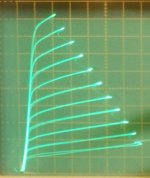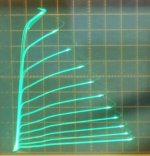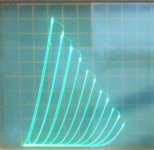hi all,
I'm not reading this place often but I have to go grab a Faylon P200 today which is in a used untested condition but was never opened and saw good storage conditions (from the seller's point of view)
this is a double EL503 push-pull which seems nice enough for decent guitar/bass abuse, or even a nice subwoofer amp...
can anyone give any information on this amp? I know this is a bargain considering the price of even a chassis and its side components so if the tubes are dead I'll buy it anyway
please see the schematic to have a better idea

I plan on a proper cleaning, rewiring and parts replacement but if anyone has better suggestions (other than put EL34s in it obviously 😉)
I'm not reading this place often but I have to go grab a Faylon P200 today which is in a used untested condition but was never opened and saw good storage conditions (from the seller's point of view)
this is a double EL503 push-pull which seems nice enough for decent guitar/bass abuse, or even a nice subwoofer amp...
can anyone give any information on this amp? I know this is a bargain considering the price of even a chassis and its side components so if the tubes are dead I'll buy it anyway
please see the schematic to have a better idea

I plan on a proper cleaning, rewiring and parts replacement but if anyone has better suggestions (other than put EL34s in it obviously 😉)
got the beast, not so bad condition but has clearly been opened before
I'll post pictures later if needed
one EL503 has a tiny blob of molten metal => flashover if I guess it right...
anyway for 60€ it's still a bargain
can somebody point me to the right direction on how to test the circuit for proper voltages/currents without damaging the amplifier?
for what I recall, paired tubes are not required for dual tubes but I may be wrong... does bias pose problems in that case?
thanks for anyone helping!
I'll post pictures later if needed
one EL503 has a tiny blob of molten metal => flashover if I guess it right...
anyway for 60€ it's still a bargain
can somebody point me to the right direction on how to test the circuit for proper voltages/currents without damaging the amplifier?
for what I recall, paired tubes are not required for dual tubes but I may be wrong... does bias pose problems in that case?
thanks for anyone helping!
correction to my previous post, those are not dual tubes as I thought but single pentodes, so will need to be paired right?
after a bit of thinking, I was wondering if it would help if I duplicated the bias circuit for each tube so that I could use any replacement without caring much about matched pairs
that particular amp is known not to sound that good, would redesigning the B+ and bias supplies be a good idea?
other components seem to be in good state, I'll make sure to post pics tomorrow as I'm off from work
that particular amp is known not to sound that good, would redesigning the B+ and bias supplies be a good idea?
other components seem to be in good state, I'll make sure to post pics tomorrow as I'm off from work
is it even worth posting a picture of the amplifier?
could anyone have some pointers?
I have sourced a spare EL503 from a friend online, but it is not paired and I don't know if those tubes or even that design is resilient regarding pairing
may I remove the extra tube from the damaged pair and readjust bias to have a single pair provide half the power?
could anyone have some pointers?
I have sourced a spare EL503 from a friend online, but it is not paired and I don't know if those tubes or even that design is resilient regarding pairing
may I remove the extra tube from the damaged pair and readjust bias to have a single pair provide half the power?
Looks like a similar amp to the Bogen MO100A:
http://www.diyaudio.com/forums/tubes-valves/273028-bogen-beasts-again.html
A minimal front end, into high gm outputs. Which are horribly expensive now. And known for unreliability.
Certainly, adding more bias adjusts is helpful. Using only a single set of tubes, you will want to connect 8 Ohm speakers to the 4 Ohm output taps.
I think I would consider converting the thing to some cheaper TV sweep tubes.
Maybe with "Schade" local feedbacks on the outputs, so the global N FDBK can be kept safely lower. A bit more gain up front needed then, so maybe use a small Mosfet Concertina phase splitter to save a tube socket.
http://www.diyaudio.com/forums/tubes-valves/273028-bogen-beasts-again.html
A minimal front end, into high gm outputs. Which are horribly expensive now. And known for unreliability.
Certainly, adding more bias adjusts is helpful. Using only a single set of tubes, you will want to connect 8 Ohm speakers to the 4 Ohm output taps.
I think I would consider converting the thing to some cheaper TV sweep tubes.
Maybe with "Schade" local feedbacks on the outputs, so the global N FDBK can be kept safely lower. A bit more gain up front needed then, so maybe use a small Mosfet Concertina phase splitter to save a tube socket.
I'd like to convert to other tubes like GU-50 or EL36 but then I'd need another PT for higher B+, or a doubler which is not a nice thing
my idea if I was to do a conversion would be to use a PFC controller as a B+ supply as it would have good characteristics and would not require a big PT
another concern is the OT, would I be able to keep it for higher impedance tubes?
I'll first try duplicating bias control for each tube and use that spare EL503, then for later on I may try converting it
my idea if I was to do a conversion would be to use a PFC controller as a B+ supply as it would have good characteristics and would not require a big PT
another concern is the OT, would I be able to keep it for higher impedance tubes?
I'll first try duplicating bias control for each tube and use that spare EL503, then for later on I may try converting it
The reason I mentioned the TV sweep tubes was that you COULD run with the same B+ and OT. Most of the TV sweep tubes can handle higher current than the audio tubes. Usually the issue is filament current with them. But going to one output pair instead of two should keep that under control. 6HJ5 would be a good fit. Can get 100 Watts out with them readily. No plate cap. 6.3 V filament. About $5 each. Excellent curves in Schade mode. (Schade and g2 drive curves attached, and pentode and "triode" curves too.) George (Tubelab) used these on Pete Millett's DCPP red board (Schaded outputs) with good results. Takes two 6CB6 drivers (7 pin), or could go to 6JC6 (9 pin) drivers. The Schade curves on these are better than a 300B. You'll need around +150V for the screen grids.
http://frank.pocnet.net/sheets/084/6/6HJ5.pdf
http://www.diyaudio.com/forums/tubes-valves/151206-posted-new-p-p-power-amp-design.html
The GU-50 will require a higher B+ and a new OT.
The PFC controller modules I have seen do not have isolation from input to output. You could run one through an isolation Xfmr I guess.
http://frank.pocnet.net/sheets/084/6/6HJ5.pdf
http://www.diyaudio.com/forums/tubes-valves/151206-posted-new-p-p-power-amp-design.html
The GU-50 will require a higher B+ and a new OT.
The PFC controller modules I have seen do not have isolation from input to output. You could run one through an isolation Xfmr I guess.
Attachments
Last edited:
You need to measure the primary impedance of that output transformer (OT). If that's really a 200 Watt amp, the primary Z could be rather low. If Zpri is less than 2500 Ohm, you may have to use something more robust for a (single pair) TV sweep output tube, like a 35LR6 or 26HU5.
thanks a lot guys, I'll have a go at a complete dismantle friday and will post pics
the transformer is massive and will be measured as I can
the transformer is massive and will be measured as I can
OK guys, after a long time I've finally been able to autopsy the beast...
sadly the output transformer is burnt through several layers of wire at the primary side
can someone direct me to a source of similar output transformers, or advise me a total conversion for guitar amp?
I have a bunch of 6080 and a pair of other tubes, but noval would be nice as I've sockets from the original design... I also have the remaining EL503 which I could resell or swap for an output transformer eventually
thanks for your input!
sadly the output transformer is burnt through several layers of wire at the primary side
can someone direct me to a source of similar output transformers, or advise me a total conversion for guitar amp?
I have a bunch of 6080 and a pair of other tubes, but noval would be nice as I've sockets from the original design... I also have the remaining EL503 which I could resell or swap for an output transformer eventually
thanks for your input!
thanks for the tip...
now I'm looking for alternate noval or magnoval tubes for anode voltages in that range and a power output of 100 to 200 watts, as I need to get another output transformer anyway
can anyone point me to a couple designs with noval/magnoval tubes? I have searched through several threads about noval/magnoval tube choice but the discussions were too complex for a novice like me and I would need some simple projects for inspiration
I have a bunch of small tubes, and the base power transformer from the faylon to play with, but I cannot design something from scratch at that point without pointers
other choice would be to put 4 6080 as I have sockets but I don't know if that is a good choice to learn (apart from being cheap tubes I could abuse)
now I'm looking for alternate noval or magnoval tubes for anode voltages in that range and a power output of 100 to 200 watts, as I need to get another output transformer anyway
can anyone point me to a couple designs with noval/magnoval tubes? I have searched through several threads about noval/magnoval tube choice but the discussions were too complex for a novice like me and I would need some simple projects for inspiration
I have a bunch of small tubes, and the base power transformer from the faylon to play with, but I cannot design something from scratch at that point without pointers
other choice would be to put 4 6080 as I have sockets but I don't know if that is a good choice to learn (apart from being cheap tubes I could abuse)
I would be easier just stay with the EL503's, alternatively, with a bit more work, it may be a good idea to take the opportunity to change the output tube sockets to either novel or octal types so you can have a wider selection of tubes to consider, such as EL36, EL509/EL519.
I'm ok but the problem is I have only three EL503 left and would prefer selling them a good price for funding the output transformer and 4 cheaper tubes, otherwise it would be a dead project (I'm a bit tight on money right now)
Or I can find alternatives like toroidal power transformers (I have a fair bunch of them) with the leftover EL503 I have...
you know, for now, I would just need a guitar amplifier to fiddle with tube amps and play guitar, and make higher grade gear later for hi-fi, so I wouldn't invest too much at this point
Or I can find alternatives like toroidal power transformers (I have a fair bunch of them) with the leftover EL503 I have...
you know, for now, I would just need a guitar amplifier to fiddle with tube amps and play guitar, and make higher grade gear later for hi-fi, so I wouldn't invest too much at this point
EL36 would work just fine, i've done this on several FBT500 amps ... you only need to provide a lower voltage supply for screens. I used a mosfet to drop the Ht to 150-160V ...
M2C
M2C
I have created a thread for buying a new output transformer...
I'm looking at an auction for a cheap 4x lot of NIB EL36 and accorded sockets, and I think I'll follow your advice
I have also got a book from Elektor on am tube design which is pretty nice and will have a good read
This thread could be moved in the instrument amps section if needed, as this is now more of a guitar amp thread
thanks for your advice guys!
I'm looking at an auction for a cheap 4x lot of NIB EL36 and accorded sockets, and I think I'll follow your advice
I have also got a book from Elektor on am tube design which is pretty nice and will have a good read
This thread could be moved in the instrument amps section if needed, as this is now more of a guitar amp thread
thanks for your advice guys!
Conversion to EL36 seems to be the way to go then, but not sure if it is well suited for a conversion to guitar amp, since you need to punch many more holes in the chassis and the front panel to accomodate the extra tubes and potentiometers required by the preamp.This thread could be moved in the instrument amps section if needed, as this is now more of a guitar amp thread.
600V on EL36?
Has anyone used th EL36 at this kind of overvoltage?
The datasheet lists 300V as the max for class B audio use.
The Faylon puts twice that voltage on the anodes.
The EL503 is also rated for 300V though...
Has anyone used th EL36 at this kind of overvoltage?
The datasheet lists 300V as the max for class B audio use.
The Faylon puts twice that voltage on the anodes.
The EL503 is also rated for 300V though...
I'm looking at a discrete/mosfet preamp, which may be external
the original frontend only has a volume pot and power switch and is not in good state, so I'll sandblast it and make a bunck of holes anyway
my general idea would be a multitool amp for anything from guitar to keyboard and voice, with versatility and sturdiness in mind
there are two small tube holes and four noval sockets in the original chassis, and I have a couple aluminum plates around for additions if needed
I'll start by redesigning the power section for matching needed voltages for a bunch of different tubes as this is the occasion to experiment with tube amps which I always wanted to do
the original frontend only has a volume pot and power switch and is not in good state, so I'll sandblast it and make a bunck of holes anyway
my general idea would be a multitool amp for anything from guitar to keyboard and voice, with versatility and sturdiness in mind
there are two small tube holes and four noval sockets in the original chassis, and I have a couple aluminum plates around for additions if needed
I'll start by redesigning the power section for matching needed voltages for a bunch of different tubes as this is the occasion to experiment with tube amps which I always wanted to do
- Status
- Not open for further replies.
- Home
- Live Sound
- Instruments and Amps
- Faylon P200 rebuild



